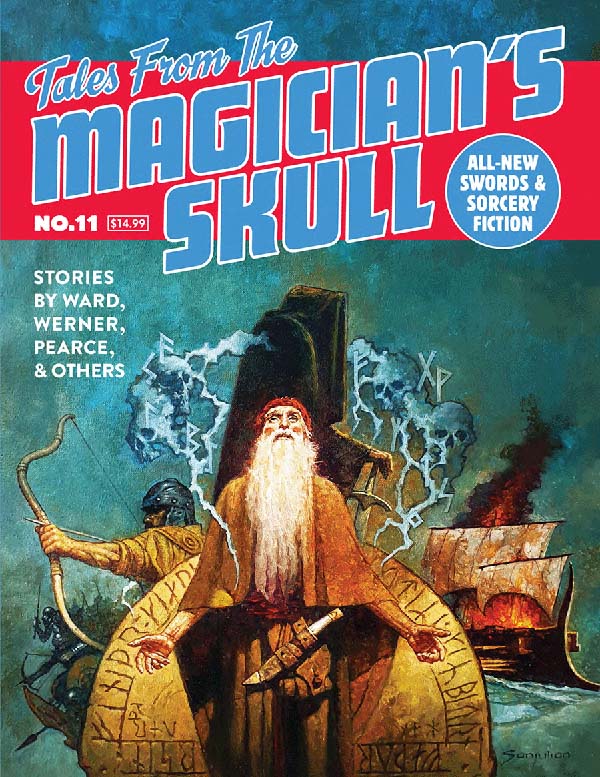Amra Who? Inside Conan’s Secret Identity
by Bill Ward
Quick trivia question: what is Conan holding in his hand when we are first introduced to the character? It’s not the bloody head of a Stygian priest or the becrimsoned blade that severed it. No, it’s a pen. Or, to be more accurate, a stylus – King Conan is improving the map of his Kingdom of Aquilonia when first we meet him in “The Phoenix on the Sword,” filling in the far, wild, northern places of the world that were but mere rumors for his civilized subjects, and doing so with his own hand. Over a lifetime of adventure, Conan had been to many such places and places stranger still, from Vanaheim to Vendhya, from The Pictish Wilderness to the Kushite Coast.
And it was upon the Kushite Coast as a raider and buccaneer that Conan received his alias, one of those other great trivia questions since it is only ever mentioned in two original Conan stories. His piratical nom du guerre is, of course, Amra, “The Lion” in Kushite. Conan-as-Amra has taken on a sort of out-sized importance beyond the very scant mentions in the stories – after all, the classic fanzine turned prozine that ran from 1959-1982 and was a showcase for Howard scholarship was itself called Amra. And this mysterious Amra period in Conan’s life—for Howard never penned any tales that covered it—has been fertile ground for pastichers and fan writers ever since. A cursory examination of some of these uses of Amra as part of Conan’s comic book or animated adventures turns up things such as Conan having a pet lion named Amra, Conan inheriting the mantle of an eternal warrior and being granted ‘Amra’ as a kind of title, and, the best one, Amra as the beast-spirit doppelganger of the Cimmerian whom Conan must fight in a duel to the death. Clearly, Amra has taken on a life of his own.
But there is more to this story. The notion of Amra as Conan’s alias is first introduced in “The Scarlet Citadel,” when Conan’s jailer recognizes him as the reaver Amra. It’s a great detail as it makes the jailer’s planned torment of Conan a much more personal threat, and it also reinforces the idea of Conan as a man who has lived many different lives and accumulated many enemies. Perhaps it’s no coincidence then that the only other mention of the pseudonym occurs in the Conan novel that was essentially the enlargement of the plot of “The Scarlet Citadel,” namely The Hour of the Dragon. Again in this story, it is people from Conan’s past that recognize him as ‘Amra,’—“[w]as this in truth that blood-thirsty ogre of the southern seas who had so mysteriously vanished years ago, but who still lived in gory legends?” – and indeed this happens when Conan hijacks a slave galley and steers it for Stygia, once again assuming his old role of sea dog along with his old alias.
It would be easy to suppose that Howard had dashed off the Amra reference in “The Scarlet Citadel,” as a fun piece of verisimilitude, and then forgot about it until he most likely revisited the story while working on The Hour of the Dragon a few years later. But there is one more Amra reference that I think is the real reason why this seeming footnote to the saga has the sort of cachet that it does in Howardiana.
In March of 1934 the dime-a-copy fanzine The Fantasy Fan—the first-ever ‘zine dedicated to Weird Fiction, which boasted a lineup of contributors that reads like a Who’s Who of the weird pulp of the times—published a story by Robert E. Howard entitled “Gods of the North.” I’ve had the extreme good fortune to not only acquire a republished facsimile of the complete run of The Fantasy Fan, in a limited release hardback from Lance Thingmaker, but the even better good fortune to have been more-or-less ignorant of its contents on my first read-through.
I knew Howard’s second Conan story, “The Frost-Giant’s Daughter” had appeared in The Fantasy Fan under the name “Gods of the North” after Weird Tales had rejected it. What pleasantly surprised me was that this tale was turned from a Conan piece, into an Amra piece. The story is nearly identical to the original draft as presented in The Coming of Conan and other modern collections, with Conan of Cimmeria replaced by Amra of Akbitana. But a further addition gives us a taste of Howard’s recent world-building. Between the submission and rejection of “The Frost-Giant’s Daughter” Howard had written both a third Conan story and his “Hyborian Age” essay that laid out the world-building groundwork for his “age undreamed of” that spanned “the years when the oceans drank Atlantis and the gleaming cities, and the years of the rise of the Sons of Aryas.” And so Amra, clearly in my opinion intended to be a different character, is one who has traveled far “from Zingara to the Sea of Vilayet, in Stygia and Kush, and the country of the Hyrkanians.”
These changes to the original draft were done before “The Scarlet Citadel” was written. So this, then, is the first incarnation of Amra, as a literal name-swap of Conan. Already the geographical character of Howard’s new world is being strongly hinted at in the story, and I suspect the character’s original origins in the Near Eastern flavored Shem may have been chosen for its artistic contrast with the frozen northern wastes that are the story’s setting: here we have a wanderer from the hot, civilized lands of the south, rubbing shoulders with vikings and frost giants. Not just a different character, but a total inversion of the basic Conan equation.
And I think it’s this odd meta-textual, almost ‘in joke’ use of Amra that is the source of its real resonance with die hard Howard fans over the years. Amra isn’t just Conan’s alias in the world of the stories, but in the publishing world as well. Had things gone differently, perhaps it would have been in the guise of Amra that Conan stories would have caught on, and the character would have surely grown into something more than a placeholder name for someone else. Conan’s first story, after all, was an extensive re-write of King Kull’s last tale, and Howard was never over-precious when it came to branding a series or doing what it took to sell.
All of which leads to my third trivia question, one that positively drips with irony in a publishing world that has seen every scrap of unpublished fiction by Howard, regardless of original intent, rebranded into commercially viable Conan fiction: Who, then, is the only author to ever change an actual Conan story into the tale of some other hero? Why, none other than Robert E. Howard himself.
For the publication chronology of the Conan saga and related information, I am indebted to Patrice Louinet’s superb essays in the collected Del Rey Conan books, Hyborian Genesis, parts I-III








